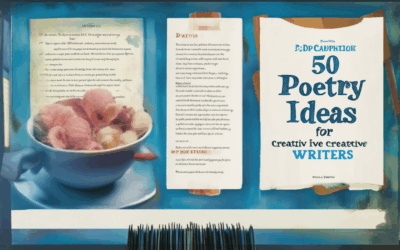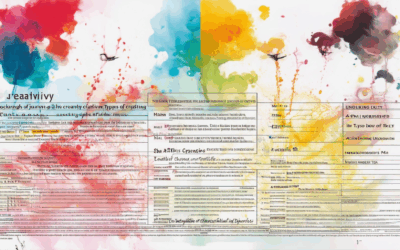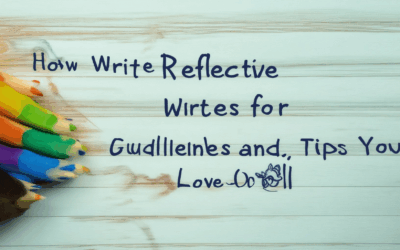Discover the power of reflective writing with our comprehensive guide. In today’s fast-paced world, finding moments of introspection is invaluable, and reflective writing offers a unique way to explore your thoughts and emotions. Whether you’re a seasoned writer or new to the craft, this blog post will walk you through the essential elements of reflective writing, complete with examples and practical tips to get you started. From understanding the 5 R’s—Recognize, Respond, Re-evaluate, Reflect—to exploring real-life examples and learning how to craft a compelling opening sentence, this guide is designed to inspire and equip you with the tools needed to master reflective writing. Join us as we delve into the art of self-discovery through words and unlock the transformative potential of reflective writing.
Key Takeaways
- Master Reflective Writing with the Three Elements: Discover how to describe events vividly, interpret their significance, and reflect on outcomes to foster deep introspection and personal growth.
- Unlock Your Potential with the 3 R’s of Reflection: Learn how resonance connects you with others’ experiences, reflection enhances self-awareness, and resilience strengthens your ability to overcome challenges.
- Craft Compelling Openings for Your Essays: Effective opening sentences engage readers, set the tone, and hint at your essay’s themes, making your reflective writing more impactful.

The 5 R’s of Reflective Writing
Reflective writing is a powerful tool for self-reflection, personal growth, and deepening understanding. It involves examining your thoughts, feelings, and experiences to foster insight and meaning. Below are the five key components of reflective writing, often referred to as the “5 R’s”:
- Report : This involves documenting your experiences in a factual and unbiased manner. It’s like taking notes or keeping a journal entry without judgment or interpretation. Effective reporting ensures that your thoughts are captured accurately for future review.
- Respond : In this stage, you engage with your thoughts and emotions. It’s about questioning assumptions, exploring feelings, and considering alternative perspectives. Responding helps you move beyond surface-level observations to deeper insights.
- Relate : Connecting your experiences to broader themes, patterns, or universal concepts. This step involves drawing parallels between your life and the world around you, helping you see your personal journey within a larger context.
- Reason : Analyzing and evaluating your thoughts and experiences. This includes logical thinking, identifying causes and effects, and making connections between ideas. Reasoning allows you to uncover underlying meanings and patterns.
- Reconstruct : Finally, you piece together your reflections into a coherent narrative. This involves organizing your thoughts, creating a story or theme, and communicating your findings effectively. Reconstruction turns raw materials into something meaningful and shareable.
By practicing these five steps, you can transform raw experiences into rich, insightful reflections that enrich your personal and professional life. Silken Drum encourages writers to explore these techniques to unlock their full potential and share their unique voices with the world. Explore our resources on reflective writing to discover more tools and techniques for your journey.
What is an Example of Reflective Writing?
Reflective writing is a process that involves examining your thoughts, feelings, and experiences to gain deeper insight and understanding. It often involves introspection and analysis, allowing you to explore complex emotions or topics in a structured way. One common form of reflective writing is journaling, where you document your daily experiences or reflections on specific events.
Example of Reflective Writing:
Imagine you’ve recently gone through a challenging experience, such as moving to a new city or dealing with a difficult decision. Reflective writing might involve sitting down with a blank page and honestly describing how you feel about the situation. You might ask yourself questions like:
- What emotions am I feeling right now?
- What caused this situation?
- How did I handle it in the past?
- What would I do differently next time?
By exploring these questions, you’re engaging in reflective writing, which can help you process emotions, clarify thoughts, and grow personally.
Steps to Approach Reflective Writing:
- Choose a Topic : Select something personal or significant that you want to explore.
- Express Emotions : Write about how you feel about the topic without judgment.
- Analyze the Situation : Look at the circumstances surrounding the topic and consider possible causes.
- Articulate Lessons Learned : Identify what you’ve gained from the experience and how it has impacted you.
Reflective writing doesn’t have a set formula, but it’s often most effective when you approach it with curiosity and openness. By dedicating time to this practice, you can uncover new perspectives and foster self-awareness.
If you’d like to explore reflective writing further, you can visit Silken Drum for tips and inspiration. Our platform is dedicated to helping writers of all levels find their voice and share their stories. Join our community today!

How to Start Reflective Writing
Reflective writing is a powerful tool for self-reflection, personal growth, and exploring complex ideas. Whether you’re writing a journal entry, composing an essay, or reflecting on life experiences, the process begins with intentionality and focus. Here’s a step-by-step guide to help you get started:
1. Choose Your Topic or Prompt
- Select a specific theme, event, or question that interests you. Examples include:
- A significant life event (e.g., a trip, a conversation, or a challenge you faced)
- A concept or idea you’ve been thinking about (e.g., love, success, or identity)
- A quote or statement that resonates with you
2. Set Clear Intentions
- Before you begin, ask yourself why you’re writing. Are you seeking clarity, processing emotions, or exploring a new perspective? Knowing your purpose helps guide your thoughts and ensures your writing stays focused.
3. Begin with a Gravitational Pull
- Reflective writing often starts with a gravitational pull—a feeling or thought that draws you inward. Pay attention to what captures your attention and use it as an entry point for your writing.
4. Write Freely and Honestly
- Don’t worry about grammar or structure at first. Write in a stream-of-consciousness style, allowing your thoughts and feelings to flow naturally. This approach helps capture raw emotions and spontaneous insights.
5. Explore Memorable Moments
- Reflect on specific memories or moments that stand out. What made them meaningful? How did they impact you? Details matter in reflective writing, so dig deep into sensory experiences and emotions.
6. Connect the Dots
- Look for patterns or connections between your thoughts and experiences. How do they relate to larger themes or concepts? This step helps you see your writing in a broader context.
7. Revise and Refine
- After drafting, revisit your writing to clarify your message and remove unnecessary parts. Polish your sentences for clarity and conciseness, ensuring your ideas resonate with your intended audience.
8. Conclude Thoughtfully
- End your reflection with a meaningful closing thought or insight. Consider how your exploration has evolved your understanding or feelings about the topic.
9. Share or Keep Private
- Decide whether to share your reflection with others or keep it private. Sharing can provide valuable feedback and deepen your understanding, while keeping it private allows for personal introspection.
10. Practice Regularly
- Reflective writing becomes easier with practice. Set aside time weekly to document your thoughts and experiences. Over time, you’ll develop a richer, more nuanced writing style.
Tools and Resources
- To enhance your reflective writing journey, consider exploring tools and resources like:
- Silken Drum , a platform dedicated to fostering creativity and reflection through writing.
- Journaling apps or digital platforms that simplify the process of capturing thoughts.
By following these steps, you can unlock the power of reflective writing and gain deeper insights into yourself and your world. Remember, the goal is to explore, grow, and find meaning in your experiences.

What Are the Three Elements of Reflective Writing?
The three primary elements of reflective writing are:
- Description
- Reflective writing begins with a clear and vivid description of the event, experience, or situation. This involves recounting the details of what happened, how it made you feel, and what you observed around you. The description serves as the foundation for exploring deeper meaning.
-
Interpretation
- After describing the experience, the next step is to interpret its significance. This means analyzing the emotions, motivations, and underlying themes that emerged during the event. Interpretation goes beyond the surface level to uncover the deeper meanings and connections.
-
Outcome
- Finally, reflective writing concludes with reflecting on the outcomes of the experience. This involves considering how the event impacted you personally, what you learned from it, and how it might influence your future actions or decisions. The outcome often ties back to personal growth or change.
By following these steps, reflective writing allows for introspection and self-awareness, helping individuals gain a better understanding of themselves and their experiences.
The 3 R’s of Reflection
The 3 R’s of reflection are Resonance, Reflection, and Resilience. These concepts provide a framework for understanding and practicing introspection effectively.
- Resonance
Resonance refers to the ability to connect with others’ experiences and ideas, creating a shared understanding. It involves recognizing patterns and parallels in one’s own journey with those of others, fostering empathy and a richer introspective experience. - Reflection
Reflection is the deliberate act of examining one’s thoughts, feelings, and experiences. It involves critical thinking and self-awareness, allowing individuals to gain insights and grow personally and emotionally. - Resilience
Resilience is the capacity to adapt and overcome challenges. Through reflection, individuals develop the strength and flexibility needed to navigate life’s difficulties, emerging stronger and more informed.
These three aspects collectively enhance self-awareness, social connection, and personal growth, making reflection a powerful tool for development and resilience.

Good Opening Sentences for Reflective Essays
A reflective essay invites readers into your thoughts and emotions, offering a window into your internal world. A strong opening sentence sets the tone, engages the reader, and hints at the themes or lessons you’ll explore. Here are five thoughtfully crafted opening sentences to inspire your reflection:
- Option 1: “One moment changed my perspective on life forever.” This sentence is personal and specific, immediately drawing the reader into a deeply introspective narrative.
- Option 2: “Reflecting on my journey, I’ve come to understand…” This option offers a broader scope, inviting the reader to join you in exploring lessons learned over time.
- Option 3: “This experience has left me thinking about…” This approach introduces a specific event and its impact, guiding the reader through your reflections.
- Option 4: “Throughout this journey, I’ve realized…” This sentence emphasizes growth and discovery, suggesting a thematic focus on learning and development.
- Option 5: “Looking back, I realize how much I’ve grown.” This option highlights self-awareness and introspection, encouraging readers to consider their own journeys.
Choose the opening sentence that resonates most with your essay’s focus. Whether you’re reflecting on a specific event or your overall growth, each option provides a unique angle to captivate your audience and guide them through your narrative.




0 Comments